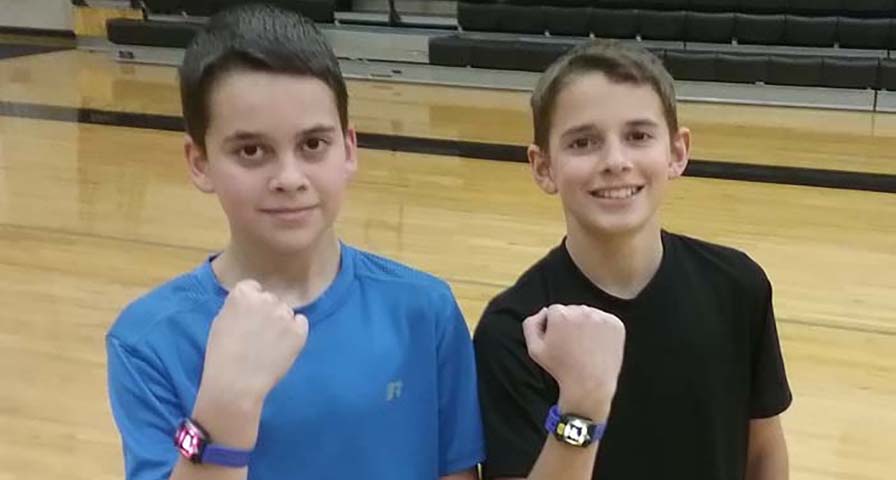1. Does my actual exertion level match the effort I think I’m giving?
Real-time feedback enables students of all ages and abilities to tie perception to reality, and when the feedback they see on the IHT ZONE wrist heart rate monitors doesn’t match what the student says, the student can self-correct or visit with a teacher to receive direction.
River Rock Intermediate School (Wisc.) PE teacher Jackie Clark had a meaningful conversation with a frustrated student who runs cross country and thought he was working harder than other students.
“We had a great conversation about how his heart is much stronger than his fellow student who wasn’t as fit. Fitness is not one size fits all and I challenged him to get in his zone the next class period,” Clark said. “That was all the motivation he needed. It was his ah-ha moment.”
2. Is my performance measured against my classmates…what if I still can’t run as fast as everyone else?
The combination of the IHT ZONE and Spirit System personalizes each class for each student by measuring each student against their own individual ability. Each ZONE PE heart rate monitor can be personalized for each student using their height, weight and max heart rate. With this data, the Spirit System determines the heart rate zones for each individual student.
At Hudson High School (Iowa), PE teacher Sean Leonard said the data helped reinforce, both to the students and to him, that students who struggle to run can still be giving their best effort.
“They are slower than most students but they are in their target zones and that has helped other students see that even though it doesn’t appear they are working hard, they really are,” he said. “That’s been helpful for everyone to see, that we are all different.”
3. Why is my heart rate still in a particular zone? What does it mean to be in each heart rate zone?
Teachers create lessons to work on different fitness skills. For some exercises, students can be performing them correctly while remaining almost in a state of complete rest – indicated by blue on the ZONE heart rate monitor. Some activities are designed for moderate exercise – yellow on the ZONE – and still others are designed for vigorous levels – red on the ZONE.
If your heart rate is the blue zone during yoga or stretching, that’s appropriate. If it’s blue when the exercise involves sprinting or a Tabata circuit, that’s different. The real-time feedback provided by the ZONE lets students know when they need to pick up the intensity – or calm it down – and confirms that they’ve selected an exercise that helps them get into the expected heart rate zone.
Oskaloosa Middle School (Iowa) PE teacher Betsy Luck gives students the freedom to pick their own activities with the expectation that they reach their goal for time spent exercising in the target zone. On a day where students needed to spend 25 minutes exercising at a moderate to vigorous level, a yoga workout, while beneficial, left the students short of their goal.
“We also talked about trying to find a day where they can do a yoga workout and why that type of workout is positive for you,” she said.
4. Can I use my heart rate to see if my fitness is improving over time?
Many teachers use recovery heart rate – your heart rate two minutes following vigorous exercise – as a marker for improved cardiovascular fitness. The quicker your heart rate slows back down following exercise, the better shape you’re in.
Skyline High School (Wash.) PE teacher Tracy Schellberg has students track their recovery heart rate several times throughout a school year. Each semester, the class gathers on the school track for a vigorous 12-minute run. Immediately after the run, students use the marker function on their ZONE monitors. This shows them exactly where their heart rate is following exercise. Two minutes later, they use the marker again. This shows them their recovery heart rate.
“Last semester, 80 percent of my students were able to drop their recovery heart rate to 120 beats per minute or less,” Schellberg said. “There was a steady improvement from the first assessment to the last.”
5. How does my heart rate relate to my grade in class?
How PE teachers grade students has for the longest time relied on either participation or perception. Did the student dress out for class? Did it look like they worked hard during class? Teachers who use the IHT ZONE no longer have to guess about students working hard. The Spirit System’s heart rate report gives both student and teacher objective data including:
- How many minutes the student spent in each heart rate zone
- How many total minutes they spent exercising in their target zones
- Whether the student met the teacher’s goal for minutes of moderate-to-vigorous physical activity.
“You can show objectively who is working hard,” Portage Central Middle School (Mich.) PE teacher John Dunlop said. “It is no longer a subjective thing. Now it’s done fairly.”
The technology helps remove any uncertainty about what’s going on in class.
“I ask that they do their best and they really bought into that,” Leonard said. “On days where motivation wasn’t as high, it was still easy for everyone to see where they were. It’s pretty easy for us as teachers to say, ‘you know, I see where you’re at, you know where you’re at in your zone, so pick it up.’ You can’t really fake it anymore. The data is going to show it all.”


